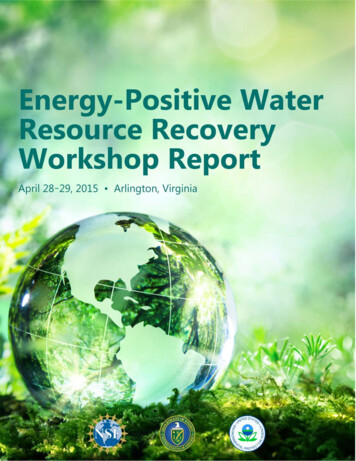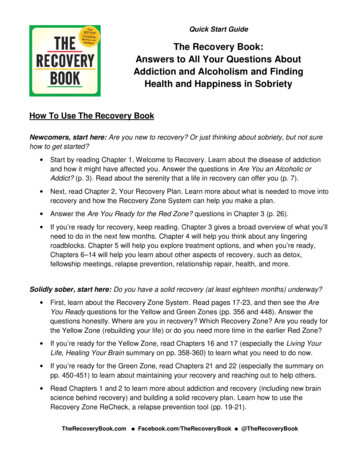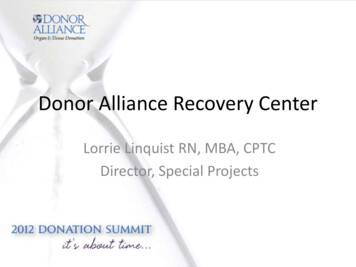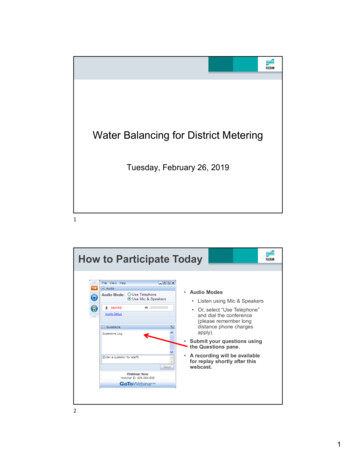
Transcription
Energy-Positive Water Resource RecoveryWorkshop ReportApril 28–29, 2015Arlington, VirginiaPrepared byEnergetics IncorporatedPrepared for an Interagency Working Group between theNational Science Foundation, U.S. Department of Energy, U.S. Environmental Protection Agency
ENERGY-POSITIVE WATER RESOURCE RECOVERY WORKSHOP REPORTFront cover: Shutterstock 274566236Back cover: Word Cloud from the wide-ranging workshop discussions. Created on rivate/203426a91f6f031668c1d9d40f791f1fSuggested Citation: NSF (National Science Foundation), U.S. DOE (U.S. Department of Energy), and U.S.EPA (U.S. Environmental Protection Agency), 2015. Energy-Positive Water Resource Recovery WorkshopReport. Workshop Date: April 28–29, 2015. Arlington, VA.DisclaimerThe views and opinions of the workshop attendees, as summarized in this document, do not necessarilyreflect those of the United States government or any agency thereof, nor does the government or itsemployees make any warranty, expressed or implied, or assume any liability or responsibility for theaccuracy, completeness, or usefulness of any information, apparatus, product, or process disclosed, orrepresent that its use would not infringe privately owned rights.NATIONAL SCIENCE FOUNDATION U.S. DEPARTMENT OF ENERGY U.S. ENVIRONMENTAL PROTECTION AGENCYI PAGE
ENERGY-POSITIVE WATER RESOURCE RECOVERY WORKSHOP REPORTPrefaceThis report captures the proceedings of the Energy-Positive Water Resource Recovery (EPWRR)Workshop hosted jointly by the U.S. Department of Energy (DOE), the U.S. Environmental ProtectionAgency (EPA), and the National Science Foundation (NSF) on April 28–29, 2015. The workshop gatheredstakeholders from industry, academia, national laboratories, and government at NSF headquarters inArlington, Virginia, to discuss barriers to the development and deployment of the water resourcerecovery facilities (WRRF) of the future. The goal of this report is to stimulate further dialog andaccelerate the wide-scale advent of advanced WRRFs. Concepts reported herein represent a synopsis ofthe perspectives and ideas generated by the experts who attended the workshop.AcknowledgementsSpecial thanks are extended to the workshop plenary speakers: Dr. Diana Bauer, DOE; Dr. KartikChandran, Columbia University; Lauren Fillmore, Water Environment Research Foundation (WERF); Dr.Brent Giles, Lux Research; Dr. Mark Kodack, U.S. Department of Defense (DOD); Paul Kohl, PhiladelphiaWater Department; Jeff Lape, EPA; Dr. JoAnn Lighty, NSF; Dr. Richard G. Luthy, Stanford University; ErikaMancha, Texas Water Development Board; Ed McCormick, the Water Environment Federation (WEF);Kerri Neary, DOE; Ben Shuman, U.S. Department of Agriculture (USDA); and Dr. Suzanne van Drunick,EPA.Sincere thanks also go to members of the Workshop Steering Committee (listed on the following page),who oversaw the planning and execution of the workshop and preparation of this report.The DOE, EPA, and NSF gratefully acknowledge the valuable ideas and insights contributed by allstakeholders who participated in the EPWRR Workshop. The willingness of these experts to share theirtime and knowledge has helped to define current and emerging opportunities to expedite developmentand deployment of innovative technologies for the next generation of WRRF. These individuals are listedin Appendix A.This report was written by Dr. Aaron Fisher, Energetics Incorporated; Jonny Rogers, EnergeticsIncorporated; and Paget Donnelly, Energetics Incorporated, with help from the Energetics Incorporatedgraphics and editing teams.Workshop facilitation was conducted under the direction of Molly Mayo of Meridian Institute.Facilitators included Gary Decker, Meridian; Selena Elmer, Meridian; Bryan Pai, SRA; and Brad Spangler,Meridian. Note taking services were provided under the direction of Dr. Aaron Fisher of EnergeticsIncorporated with support by Becca Price, Paget Donnelly, and Caroline Kramer, all of EnergeticsIncorporated.NATIONAL SCIENCE FOUNDATION U.S. DEPARTMENT OF ENERGY U.S. ENVIRONMENTAL PROTECTION AGENCYII PAGE
ENERGY-POSITIVE WATER RESOURCE RECOVERY WORKSHOP REPORTWorkshop Steering CommitteeTamara Battle, Engineering and Science Analyst, Division of Chemical, Bioengineering, Environmental,and Transport Systems (CBET), NSFDr. Diana Bauer, Director, Office of Energy Systems Analysis and Integration, Office of Energy Policyand Systems Analysis (EPSA), DOEDr. William J. Cooper, Program Director, CBET, NSFDr. Aaron Fisher, Senior Engineer and Program Lead, Energetics IncorporatedDr. Bruce Hamilton, Program Director, CBET and Office of Emerging Frontiers and MultidisciplinaryActivities, NSFScott Hutchins, Technology Manager, Advanced Manufacturing Office, Office of Energy Efficiency andRenewable Energy (EERE), DOEJeff Lape, Deputy Director, Office of Science and Technology (OST), Office of Water (OW), EPAArdra Morgan, Senior Advisor, Office of Research and Development, EPADr. Mark Philbrick, Oak Ridge Institute for Science and Education (ORISE) Science and TechnologyFellow, Bioenergy Technologies Office, EERE, EPSA, DOEGrace Richardson, ORISE Research Fellow, OW, EPA, now with Alexandria Renew EnterprisesBob Rose, OW, EPADr. Brandi Schottel, American Association for the Advancement of Science, Science and TechnologyFellow, CBET, NSFDr. Tom Speth, Director, Water supply and Water Resources Division, National Risk ManagementResearch Laboratory, EPADr. Sarah Studer, EERE Postdoctoral Fellow, Fuel Cell Technologies Office, EERE, DOEJason Turgeon, Environmental Scientist, Region 1, Energy and Climate Unit, EPADr. Jeff Yang, Scientist, EPANATIONAL SCIENCE FOUNDATION U.S. DEPARTMENT OF ENERGY U.S. ENVIRONMENTAL PROTECTION AGENCYIII PAGE
ENERGY-POSITIVE WATER RESOURCE RECOVERY WORKSHOP REPORTAcronymsADAnaerobic digestionAnFMBRAnaerobic fluidized membrane bioreactorAnMBRAnaerobic membrane bioreactorAnammoxAnaerobic ammonium oxidationBETODOE Bioenergy Technologies OfficeBGNDRFBrackish Groundwater National Desalination Research FacilityCBETNSF Division of Chemical, Bioengineering, Environmental, and Transport SystemsCHGCatalytic hydrothermal gasificationCNGCompressed natural gasCRRCCodiga Resource Recovery Center at Stanford UniversityCWAClean Water Act of 1972DARPADefense Advanced Research Project AgencyDODU.S. Department of DefenseDOEU.S. Department of EnergyDPRDirect potable reuseEPAU.S. Environmental Protection AgencyEPSAEnergy Policy and Systems AnalysisEPWRREnergy-Positive Water Resource RecoveryESCOEnergy service companyESPCEnergy savings performance contractFCTODOE Fuel Cell Technologies OfficeFOForward osmosisHTLHydrothermal liquefactionLNGLiquefied natural gasMGDMillions of gallons per dayMxCMicrobial electrochemical cellNACWANational Association of Clean Water AgenciesNSFNational Science FoundationPROPressure retarded osmosisR&DResearch and developmentRDD&DResearch, development, demonstration, and deploymentUSDAU.S. Department of AgricultureWEFWater Environment FederationWERFWater Environment Research FoundationWRRFWater resource recovery facilityNATIONAL SCIENCE FOUNDATION U.S. DEPARTMENT OF ENERGY U.S. ENVIRONMENTAL PROTECTION AGENCYIV PAGE
ENERGY-POSITIVE WATER RESOURCE RECOVERY WORKSHOP REPORTExecutive Summary: Transitioning from water treatment toresource recoveryThe aging U.S. water infrastructure will require an investment of about 600 billion over the next 20years if it is to continue reliably transporting and treating wastewater and delivering clean drinkingwater. 1 This massive investment marks an opportunity to apply new knowledge and technology andrethink the design and functionality of the water management infrastructure. Building on industry’spioneering efforts to reduce energy usage and increase the recovery of valuable resources fromwastewater, the United States can seize this opportunity to create a world-class water infrastructure,while reducing the costs to run it. Aside from the critical financial benefits, society would benefit fromcleaner water, reduced landfilling, increased resilience to climate change, and more sustainableutilization of resources. In pursuit of this vision,Water Resource Recovery Facilitystakeholders have outlined an appropriate federalrole to support industry in advancing the state of theThe term “water resource recovery facility”(WRRF) is used throughout this document at theart for water resource recovery facilities (WRRFs)behest of the water treatment community towhile reducing or even eliminating the nearly 1% ofreflect a shift in self-identification; it replaces theU.S. electricity currently used to collect, transport,term “wastewater treatment plant.”and treat wastewater. 2The National Science Foundation (NSF), the U.S. Environmental Protection Agency (EPA), and the U.S.Department of Energy (DOE) jointly hosted the Energy-Positive Water Resource Recovery (EPWRR)Workshop to envision a transition from the wastewater treatment facilities of today to a new generationof WRRFs nationwide and identify specific opportunities to stimulate and support this transition. TheU.S. Department of Agriculture (USDA) and the Department of the Army also participated in thisworkshop at the NSF headquarters in Arlington,WRRF of the FutureVirginia, on April 28–29, 2015. Participants providedAs used in this document, “WRRF of the Future”information to federal stakeholders about ongoingrefers to the workshop participants’ vision of theindustry efforts 3 and how federal activities could bestfacilities that are expected to recover water andamplify and help realize the industry vision for theother resources by 2035 or before.WRRF of the Future.Envisioning the Utility of the FutureAs envisioned by the workshop participants, the WRRF of the Future should continue to assign toppriority to wastewater treatment for the protection of human health and the environment but shouldalso expand its slate of services and products in support of healthy, economically vibrant communities. 4For example, the future WRRF could effectively manage more diverse waste streams, generate fuel,produce water and fertilizer, and help communities recover other valuable resources. To achieve this1U.S. Environmental Protection Agency. “Water Infrastructure and Resiliency Finance Center.” Accessed July 27, ncecenter.cfm.2 30.2 billion kilowatt hours: Pabi, B., A. Amaranth, R. Goldstein, and L. Reekie. Electricity Use and Management in the Municipal Water Supplyand Wastewater Industries. Electric Power Research Institute and Water Research Foundation, 3 For more information, please see: National Association of Clean Water Agencies (NACWA), Water Environment Federation, and WaterEnvironment Research Foundation. Water Resource Utility of the Future 2015, Executive Summary. Washington, DC: NACWA, 0wruotf-exs.pdf.4 This section identifies the idealized characteristics of a future WRRF.NATIONAL SCIENCE FOUNDATION U.S. DEPARTMENT OF ENERGY U.S. ENVIRONMENTAL PROTECTION AGENCYV PAGE
ENERGY-POSITIVE WATER RESOURCE RECOVERY WORKSHOP REPORTvision, the ideal WRRF of the Future should use and recover resources efficiently, coordinate withutilities and other community services, engage customers and the public in new ways, and deploy arange of smart technology and systems. Resource Efficiency and Recovery—Beyond merely treating wastewater, WRRFs of the Futureshould emphasize the recovery of diverse resources, including water, nutrients, and energy.WRRF systems should effectively and economically safeguard public health and the environmentwhile producing water, power, and products to meet community needs and standards. Successin recovering nutrients, minimizing energy use, and reducing emissions would ultimatelytransform these facilities from necessary public systems into prized community assets. Integration with Other Utilities—To meet the growing demand for clean water, WRRFs shouldcontinue to treat variable wastewater streams to high standards. In addition, WRRFs couldproduce electricity, lesser water grades, and saleable products that efficiently and economicallyserve a mix of shifting local priorities. WRRFs could optimize the recovery and tailoredtreatment of local wastewater and other waste streams to meet the specialized needs of powerplants, manufacturing plants, agricultural systems, local governments, health agencies, andother institutions. Engaged and Informed Communities—To shift current community perceptions of wastewatertreatment toward positive associations with resource recovery, WRRFs should actively engagewith their customers, elected officials, industry, and the public. Initial outreach efforts shouldexpand public understanding of sustainable water resources and awareness of WRRF goals.Communities may advocate for WRRFs that reduce carbon emissions, support greeninfrastructure development, and drive economic growth. Customers can contribute to thesuccess of the WRRFs of the Future by better managing waste at the source. Ultimately,effective customer engagement could improve public infrastructure and increase local supportfor net-zero-water buildings and other integrated solutions to water, energy, and food supplies. Smart Systems—Future WRRFs could use a host of sensors, software, and innovative equipmentto track performance and inform plant operations. Smart systems would enable facilities toactively monitor the volume and content of incoming waste streams, supervise plant operations,and verify the safety or quality of outputs to enable real-time adjustments in processingparameters. These facilities could potentially scale up or down as needed to maintaineconomical operations under shifting conditions. Advanced technologies could support facilityintegration beyond traditional plant boundaries, e.g., enabling coordination with the localpower company to facilitate demand-response activities.Research OpportunitiesWorkshop participants prioritized 16 areas in which concerted research is likely to deliver significantprogress. Six of these topic areas are for the near term, five are long term, and five span both the nearand long term (see Figure ES-1 and Table ES-1). Research, development, and demonstration in theseareas could further catalyze industry investment in building the WRRF of the Future.Aeration represents the largest energy-consuming operation at a WRRF. Participants identified anumber of research opportunities that could reduce or even eliminate the need for aeration. Forexample, shortcut nitrogen removal—anaerobic ammonium oxidation (anammox)—would eliminate theNATIONAL SCIENCE FOUNDATION U.S. DEPARTMENT OF ENERGY U.S. ENVIRONMENTAL PROTECTION AGENCYVI PAGE
ENERGY-POSITIVE WATER RESOURCE RECOVERY WORKSHOP REPORTneed to aerate during denitrification, and constructed wetlands might also be used to reduce aerationneeds, though throughput remains a challenge in natural systems. Research area prioritized by a single breakout group; Research area prioritized by two different breakout groups; Research area prioritized by three different breakout groups; Research area prioritized by all four breakout groupsFigure ES-1: Prioritized Research OpportunitiesSludge disposal is one of the largest expenses at WRRFs. Improved solids deconstruction would betterbreak down the biomass, increasing the production of biogas and reducing the remaining digestate.Workshop participants similarly identified anaerobic membrane bioreactors and fluidized bedmembrane bioreactors as technologies that could enhance anaerobic digestion (AD) and reduce thevolume of sludge for disposal. Together, research on sludge and aeration could significantly reduceenergy consumption, increase energy recovery, and minimize the costs of sludge disposal.Deployment ChallengesIn considering potential pathways toward the WRRF of the Future, workshop participants identified keychallenges to be overcome. These challenges include regulatory, technical, social, and financial barriers.While compliance with water treatment standards will remain the core mission of future facilities, thislong-standing priority has promoted a risk-averse culture. As a result, many facilities today aredisinclined to deploy and validate advanced resource recovery technologies that could generateeconomic value. Pioneering facilities are needed to scale up promising technologies, validate them, andhelp set the standards for safely integrating resource recovery into existing and future WRRFs.Financing and social acceptance are pivotal issues in deploying these novel technologies. Financingposes a perpetual challenge for the research, development, demonstration, and deployment (RDD&D)of water resource recovery technology. Many WRRFs operate as regulated utilities in structures thatleave little revenue for research or innovation. Without capital improvement budgets, these facilitiesnecessarily focus on maintaining existing services instead of building for the future. A betterunderstanding of environmental sustainability, including the social costs of water and carbon pollution,would help justify funding for water resource recovery. Public awareness of the long-term benefits andNATIONAL SCIENCE FOUNDATION U.S. DEPARTMENT OF ENERGY U.S. ENVIRONMENTAL PROTECTION AGENCYVII PAGE
ENERGY-POSITIVE WATER RESOURCE RECOVERY WORKSHOP REPORTreliability of these systems could also help attract financing and stimulate adoption of promising waterresource recovery technologies.Table ES-1: Research Priorities Identified by the Four Parallel Participant Breakout Groups*Near-Term Priorities1. Shortcut nitrogen removal(anammox) eliminates the need toaerate the sludge, sharply reducingenergy use for denitrification.(2 groups) 2. Improved solids deconstructionmakes nutrients more accessible inanaerobic digesters, increasingbiogas production and reducingsolids handling.‡3. Water reuse for targeted potableand non-potable applications couldreduce stress on existing drinkingwater supplies and deliver energybenefits.4. Compressed natural gas /liquefiednatural gas powered vehicles couldutilize upgraded biogas.5. Using omics as a platform(combining fields such as genomics,proteomics, transcriptomics, andmetabolomics) could improve thebiological processes associated withwater treatment. (2 groups) 6. Constructed wetlands should beevaluated as an option for nutrientand pollutant remediation. Both Near- and Long-Term PrioritiesLong-Term Priorities1. Real-time control systems, processmonitoring, and systems integrationcould provide greater insight intoplant operations and improve thereliability and efficiency of WRRFs.(3 groups) 2. Anaerobic membrane bioreactorsand fluidized bed membranebioreactors could increase biogasproduction; reimagining anaerobicdigestion as a continuous process(versus traditional batch flow) wouldgive microbes more time to digestthe sludge. (4 groups)‡3. Algae-based systems could leverageexisting treatment technologies withphotosynthetic resource recovery.(3 groups) ‡4. Hydrothermal processes could beused to convert biomass fromwastewater into higher-valueproducts. (2 groups) 5. Heat recovery from wastewatercould be used to offset energydemands at the WRRF andthroughout the sewage network.(3 groups)1. Modular integrated systemsreduce the physical andenvironmental footprint ofwastewater treatment and enablerapid, distributed deployment.(2 groups)2. Methanogens research couldimprove the resiliency, yields, andthroughput of the microbes thatdigest organic material andproduce methane. (2 groups)‡3. Forward osmosis could be used inbioreactors to recover energy andremove pollutants fromwastewater streams.4. Microbial electrochemical cellscan be used to generate hydrogen,electricity, or higher-value biofueland bioproduct precursors.5. Source separation anddecentralization linked to urbanplanning could enable systemstailored for specific feedstocks orpurposes and reduce dependenceon major infrastructure. (2 groups)Note: Research on topics in this categorymay need to begin in the near term andcontinue throughout the long term.*Numbering within a time period indicates relative prioritization. Priority directly reduces need for aeration, the largest energy consuming operation at a WRRF.‡Priority directly reduces costs associated with sludge treatment and disposal, which are among the highest WRRF costs.Other identified priorities indirectly address costs and energy needs in the operation of a WRRF.Moving ForwardAs water treatment facilities, pipes, and related infrastructure in cities around the country approach theend of their expected service life, a unique window of opportunity exists to replace the aginginfrastructure with the WRRF of the Future—reducing stress on energy systems, decreasing air andwater pollution, building resiliency, and driving local economic activity.NATIONAL SCIENCE FOUNDATION U.S. DEPARTMENT OF ENERGY U.S. ENVIRONMENTAL PROTECTION AGENCYVIII PAGE
ENERGY-POSITIVE WATER RESOURCE RECOVERY WORKSHOP REPORTNATIONAL SCIENCE FOUNDATION U.S. DEPARTMENT OF ENERGY U.S. ENVIRONMENTAL PROTECTION AGENCYIX PAGE
ENERGY-POSITIVE WATER RESOURCE RECOVERY WORKSHOP REPORTContentsDisclaimer. iPreface . iiAcknowledgements. iiWorkshop Steering Committee . iiiAcronyms . ivExecutive Summary. vContents . xIntroduction . 1A Multi-Agency Workshop . 2Wastewater as a Resource. 4Simplified View of Water Resource Recovery Facility Operations . 4WRRF Operation Metrics . 5The Water Resource Recovery Facility of the Future . 10Resource Efficiency and Recovery . 10Integration with Other Utilities. 11Engaged and Informed Communities . 13Smart Systems. 14Challenges to Advancing the State of the WRRF . 17Regulatory . 17Technology Deployment and Validation Challenges . 17Research Challenges . 18Social and Behavioral Challenges. 19Financial Challenges . 20Challenges of Upgrading Existing Facilities . 21Research Opportunities . 23Near-Term Opportunities . 31Both Near- and Long-Term Opportunities . 33Long-Term Opportunities. 35Conclusion . 38Appendix A: Attendee List . 39Appendix B: Workshop Agenda . 41Appendix C: Summary Images of Individual Groups . 43NATIONAL SCIENCE FOUNDATION U.S. DEPARTMENT OF ENERGY U.S. ENVIRONMENTAL PROTECTION AGENCYX PAGE
ENERGY-POSITIVE WATER RESOURCE RECOVERY WORKSHOP REPORTIntroductionAmerica’s water infrastructure, once widely recognized as a world-class system, now suffers fromadvanced age and decades of underinvestment. The high cost of maintaining this critical infrastructurehas given rise to nascent technologies and innovative water treatment strategies that offer tremendouspromise.People across the United States enjoy high-qualitydrinking water, as legislated under the Clean WaterAct (CWA) of 1972 and the Safe Drinking Water Act of1974. Under the authority of these acts andsubsequent legislation, the federal government hasprovided more than 100 billion to core wastewaterand drinking water infrastructure assistance programssince 1973. The bulk of this federal support cameprior to the mid-1990s—aside from funds provided bythe Recovery Act of 2009. This decline in funding hasleft many WWRFs without the resources to pursueimprovements. 5The need to repair or replace critical water treatmentequipment, pipelines, and sewer systems, some ofwhich are now up to 100 years old, is growing moreurgent. Our nation’s wastewater systems now releasebillions of gallons of raw sewage into local waterwayseach year. In addition, old water mains leak trillions ofgallons of clean drinking water—worth billions ofdollars—each year. Addressing such infrastructureissues for both wastewater and drinking water willrequire an estimated 600 billion over the next 20years. 6 The required investment to repair or replacesubstantial sections of our aging water infrastructureis now beyond the reach of many local governmentsand traditional federal grant programs.The emerging and projected impacts of climatechange will likely exacerbate the burden alreadyplaced on our aging water infrastructure. Climatechange impacts like drought, severe storms, andflooding pose additional challenges for this essentialinfrastructure.56Defense Department Transports25 Times More Water than FuelIn fiscal year 2013, the U.S. Department ofDefense (DOD) consumed more than 90 billiongallons of potable water and only 3.5 billiongallons of fuel—nearly 25 times more waterthan fuel by volume. DOD recognizes theimportance of reducing water use to enableagile operations and is on track to exceed thefederal goal (for all agencies) to reduce wateruse 26% by 2020 (relative to a 2007 baseline).In pursuit of reducing water needs at bases,DOD’s Strategic Environmental Research andDevelopment Program and EnvironmentalSecurity Technology Certification Programharness the latest science and technology todevelop and demonstrate innovative, costeffective, and sustainable solutions. With regardto sustainable basing, the following R&D goalshave been announced: 75% reduction in water25% reduction in energy50% reduction in solid wasteU.S. Department of Defense. Annual EnergyManagement Report: Fiscal Year 2013. Office of theDeputy Under Secretary of Defense, 2014.www.acq.osd.mil/ie/energy/energymgmt report/FY%202013%20AEMR.pdfU.S. Department of Defense (DOD). Fiscal Year 2012Operational Energy Annual Report. DOD, s/Reports/20131015 FY12 OE Annual Report.pdf.Kodack, Mark. Personal communication, April 29,2015.Copeland, Claudia, “Funding for EPA Water Infrastructure: A Fact Sheet,” Congressional Research Service Report. June 19,2015. assets/crs/R43871.pdfU.S. Environmental Protection Agency. “Water Infrastructure and Resiliency Finance Center.” Last modified May 6, ncecenter.cfmNATIONAL SCIENCE FOUNDATION U.S. DEPARTMENT OF ENERGY U.S. ENVIRONMENTAL PROTECTION AGENCY1 PAGE
ENERGY-POSITIVE WATER RESOURCE RECOVERY WORKSHOP REPORTActivities are underway at federal, state,
ENERGY-POSITIVE WATER RESOURCE RECOVERY WORKSHOP REPORT NATIONAL SCIENCE FOUNDATION U.S. DEPARTMENT OF ENERGY U.S. ENVIRONMENTAL PROTECTION AGENCY II PAGE Preface This report captures the proceedings of the Energy-Positive Water Resource Recovery (EPWRR) Workshop hosted jointly by the U.S. Department of Energy (DOE), the U.S. Environmental Protection










